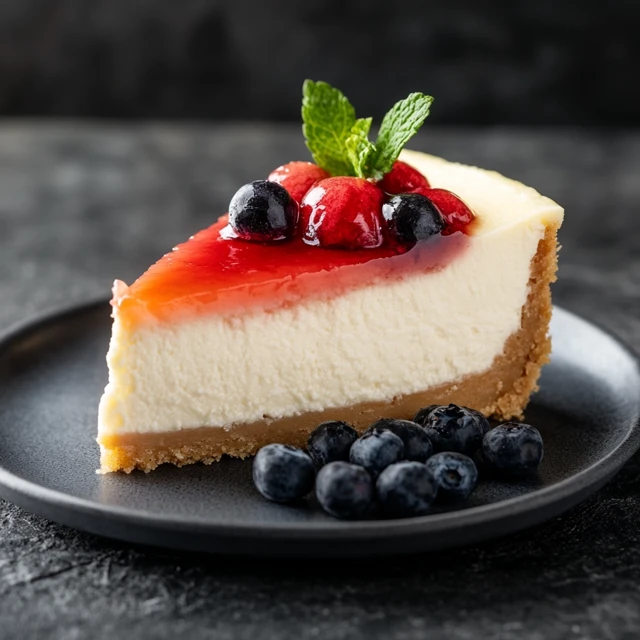
Cheesecake is one of the most popular desserts worldwide, but many home bakers find themselves asking: Is it better to bake or not bake a cheesecake? Both baked and no-bake versions have their merits, and choosing between the two depends on various factors, such as texture preference, preparation time, and occasion. In this article, we’ll explore the pros and cons of both methods, helping you decide which cheesecake is best for your next sweet treat.
What is a Baked Cheesecake?
A baked cheesecake is the traditional version of this dessert. It typically consists of a graham cracker or biscuit base, filled with a rich mixture of cream cheese, eggs, sugar, and sometimes sour cream. This filling is baked in the oven, usually in a water bath, to achieve a smooth, creamy texture. After baking, the cheesecake needs to cool completely and set in the fridge overnight.
Baked cheesecakes are known for their dense and rich texture. To achieve the best results, check out these helpful tips on making The Ultimate Baked Strawberry Cheesecake, which also shares some useful techniques for preventing cracks during the baking process.

What is a No-Bake Cheesecake?
If you’re looking for a quicker and easier cheesecake option, a no-bake cheesecake is the way to go. It requires no oven time, relying on refrigeration to set the filling. The ingredients are similar to baked cheesecake but typically exclude eggs. Instead, whipped cream or gelatin is used to help the filling firm up. This version of cheesecake is lighter, creamier, and perfect for warmer days when you want to avoid turning on the oven.
For a delightful fusion of cheesecake with a unique twist, you might also enjoy the Sopapilla Cheesecake Recipe, which offers a fun and easy dessert that doesn’t require baking.
Key Differences Between Baked and No-Bake Cheesecake
When deciding whether to bake or not bake your cheesecake, here are some key differences to keep in mind:
- Texture: Baked cheesecakes are dense and firm, while no-bake cheesecakes are light and creamy.
- Flavor: Baking enhances the flavor of the cheesecake, producing a deeper, richer taste. No-bake cheesecakes, on the other hand, tend to have a fresher and more tangy flavor.
- Preparation: Baked cheesecakes require more time for preparation and baking, followed by hours of chilling. No-bake cheesecakes are quicker to prepare and set, usually requiring just a few hours in the fridge.
For those interested in exploring more cheesecake varieties, check out Splash of Recipes’ guide on What is the Difference Between New York Style Cheesecake and Regular Cheesecake?.
Texture and Mouthfeel

A significant factor in choosing between baked and no-bake cheesecakes is the texture. A baked cheesecake offers a smooth, dense texture that’s achieved by the incorporation of eggs and the slow baking process. Many people prefer this traditional texture, which has a rich, almost custard-like consistency.
In contrast, a no-bake cheesecake is much lighter and airier. Its texture is closer to a mousse, making it a more refreshing dessert, especially during hot summer months. Both textures have their own appeal, depending on your preference.
Flavor Profiles
Flavor is another important consideration when choosing between baked and no-bake cheesecakes. A baked cheesecake tends to have a deeper, more complex flavor due to the caramelization of the sugars during baking. The baking process also helps to meld the flavors of the ingredients together.
No-bake cheesecakes, on the other hand, maintain a fresher, tangier taste since the ingredients aren’t cooked. This makes them ideal for desserts that incorporate fresh fruit toppings or lighter flavors.
For more delicious cheesecake variations, you might enjoy reading The Ultimate Strawberry Cheesecake Recipe, which provides step-by-step instructions for making this classic dessert.
Preparation and Convenience
If convenience is a priority, a no-bake cheesecake is definitely the easier option. Without the need for an oven or worrying about the cheesecake cracking, no-bake cheesecakes can be made quickly and left to chill in the fridge until ready to serve.
However, if you prefer a more traditional cheesecake with a richer flavor and denser texture, the extra effort required for a baked cheesecake is well worth it. For an extra creamy baked cheesecake, try using a water bath to ensure even baking and prevent cracks on the surface.
For more tips on preventing cracks and achieving the perfect texture, check out this helpful guide on Easy Cheesecake Recipe Tips.
FAQs
Is it easier to make a no-bake cheesecake than a baked cheesecake?
Yes, no-bake cheesecakes are generally easier to make. They require fewer steps, no oven, and less preparation time. They are perfect for beginners or anyone looking for a quick dessert option.
How long should a baked cheesecake cool before eating?
A baked cheesecake should cool at room temperature for about an hour before being placed in the fridge to chill for at least 4 hours, but preferably overnight, to set properly.
Why does a baked cheesecake crack, and how can you prevent it?
Cracking usually occurs when a cheesecake is overbaked or cooled too quickly. Using a water bath during baking helps create a more stable environment for the cheesecake, preventing cracks.
Can I use the same filling for both baked and no-bake cheesecakes?
No, the fillings differ slightly. Baked cheesecakes require eggs to set, while no-bake cheesecakes often use gelatin or whipped cream as a stabilizer.
Conclusion: Which Cheesecake is Better?
Both baked and no-bake cheesecakes have their strengths, and the choice depends on your personal preferences. If you want a rich, dense dessert for a special occasion, go with a baked cheesecake. If you’re after something light, refreshing, and quick to make, a no-bake cheesecake is your best bet.
By trying both methods, you’ll be able to enjoy the best of both worlds and always have the perfect cheesecake for any occasion.


2 thoughts on “Is It Better to Bake or Not Bake a Cheesecake?”